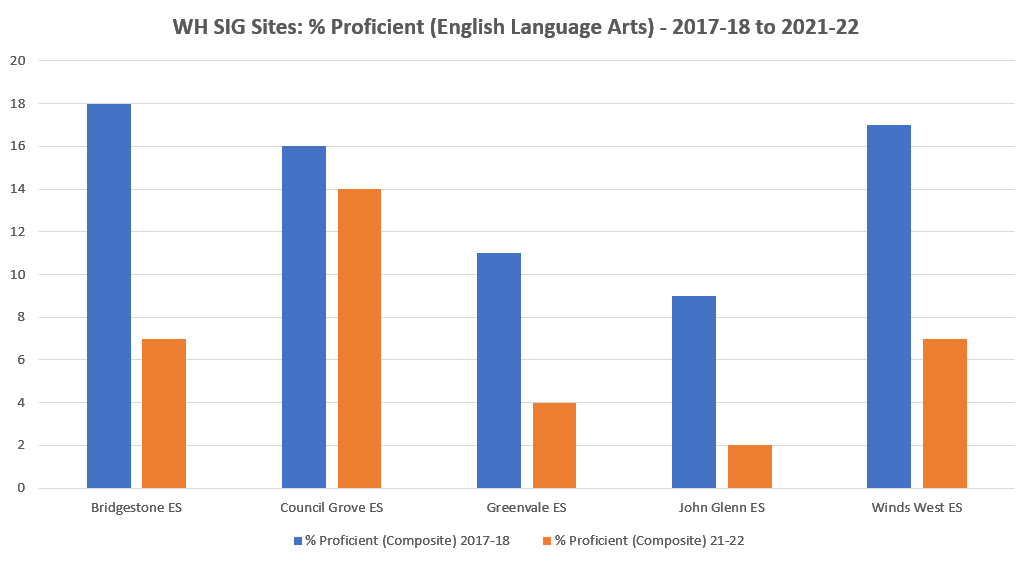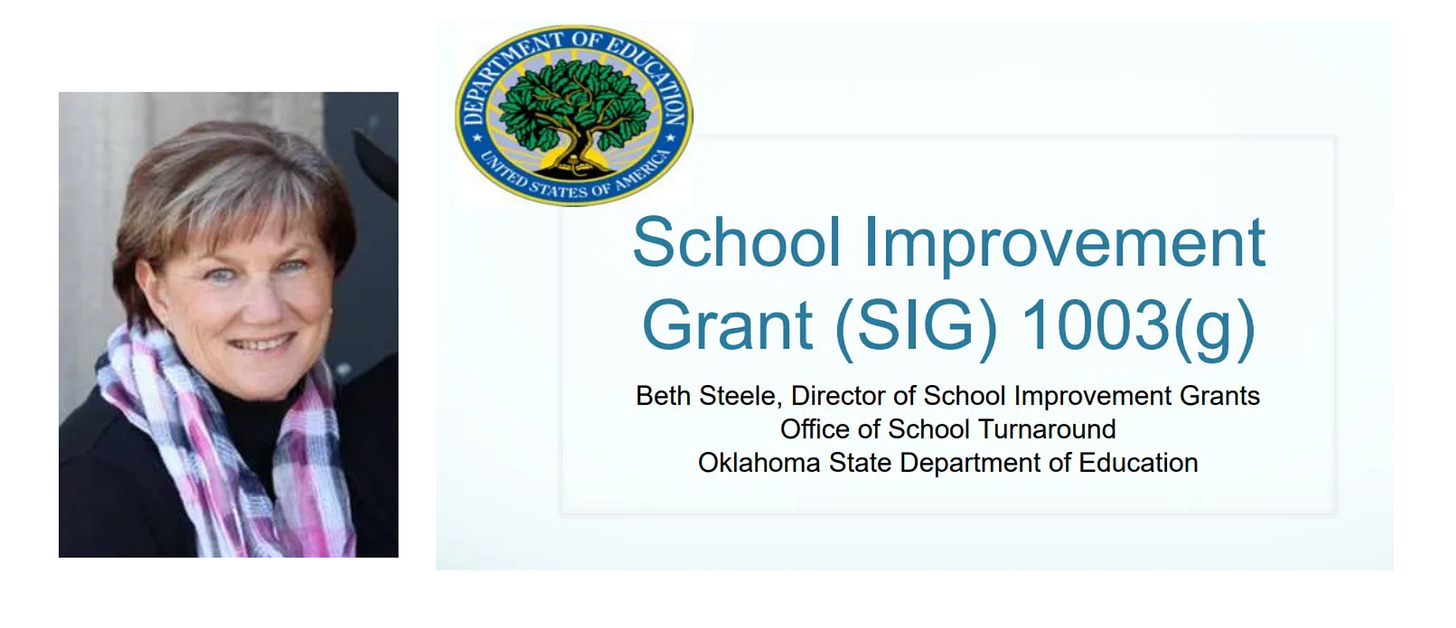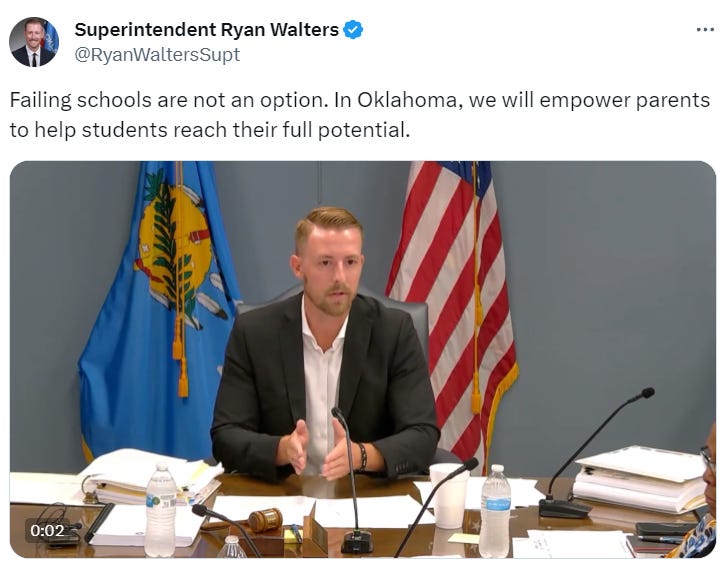Hofmeister Let Western Heights Grant Grift $5 Million Then Lost Control, Walters Left to Clean Up Mess
OSDE Staff Member Grants Then Follows Funds to Western Heights
Money for Nothing: Schools Incented to Fail and Fail Badly
Many taxpaying citizens are unaware that failing public school districts and sites, if they can manage to fail badly enough, have access to additional funds from the Oklahoma State Department of Education (OSDE) beyond what they already receive each year in federal and state matched money. The idea was to bolster the lowest performing schools toward improved student outcomes, but has it worked?
At Western Heights Public Schools, the answer is no. It appears this financial opportunity has encouraged not academic improvement for kids, but an increase in administrative positions, salaries and unhelpful ideologies. A closer look at one such funding stream, a four-year federal grant program, suggests concerning, perhaps even lawless activity at both the state and district levels.
Did Hofmeister Staff Member Participate in Western Heights Pay-to-Play Arrangement?
In the Fall of 2015, the OSDE, then under the direction of State Superintendent of Public Instruction Joy Hofmeister (R then D), awarded all of the state’s available School Improvement Grant (SIG) money within a competitive grant process to Western Heights Public Schools. At the time, the district was under the direction of longtime Superintendent Joe Kitchens (1995-2019).
According to OSDE guidance for SIG at that time, the funds were for “Title I Priority and Focus Schools that demonstrate the greatest need for the funds and the strongest commitment to use the funds to provide adequate resources in order to substantially raise the achievement of their students.”
Priority schools are those in the bottom 5% of student performers or having a graduation rate below 60% for three consecutive years (high schools). Focus schools are similarly underperforming schools who serve a higher than state average percentage of “students with disabilities (IEP), and/or African American subgroups.”
According to OSDE records, more than 600 school sites were annually eligible to apply for these funds around that time, yet Western Heights, through five school site applications, was awarded $4,952,170 of the total of $5,000,000 available that year through the OSDE.
The numbers are very neat. The remaining $47,830 wasn’t enough to fund even one school site from any other district that year. OSDE would have just one district to work with for that grant period. However, the plan may have been a bit more personal than convenient logistics.
Who Really Benefitted from This Financial Arrangement?
How exactly did one district walk away with all funding in a statewide grant competition involving taxpayer money? Easily, and right under Hofmeister’s nose. A woman named Beth A. Steele was principal at Shidler ES (OKCPS), then very briefly was hired by Hofmeister as the OSDE’s Director of School Improvement Grants.
A man named Hayden Roberts, then Director of Community Resources for Western Heights Public Schools, wrote and submitted multiple applications for the SIG grant money on behalf of five school sites in his district.

Immediately after awarding Western Heights all of the SIG grant money available for that year for the entire state, Steele left the OSDE to take a much higher paying position at Western Heights as District Executive Director of Elementary Improvement handling the same $5 million in taxpayer funding she had just played a key role in awarding.
Steele enjoyed a significant bump in pay for her troubles. Prior to following the SIG funds to Western Heights, Steele earned an annual salary of $60K as a principal (2014) and $62K annually as SIG director at OSDE (late 2015-mid 2017). As of her retirement from WH in 2022, Steele’s annual base pay was $95,507 with a total compensation package including fringe pay and benefits of over $125K annually, a bargain for the district given the federal grant money involved.
Steele then rode out the four years of SIG funds (ended in 2020), and thanks to her three last years of earnings being significantly higher than it would’ve been, will collect a much larger monthly check from teachers’ retirement in perpetuity. According to a formulated calculator from the Oklahoma Teachers’ Retirement System, Steele will collect approximately $1,500 more per month during her entire retirement thanks to her jump to Western Heights. In just 20 years, that’s $360,000 in extra money.
Similarly, Roberts, as the inside man at WH, enjoyed a final (2018-19) compensation package of over $123K annually. Roberts jumped ship at Western Heights amid increasing focus concerning the district’s financial management and dismal student testing scores. Roberts is currently Assistant Dean at Oklahoma State University Institute of Technology in Okmulgee.
Within a 2019 podcast, Steele and then Assistant Superintendent Brayden Savage (now WH Superintendent) refer to Steele as the “turnaround officer” overseeing the SIG grant for the district. Steele calls the path to getting the funds a competitive and “rigorous grant process”, further stating, “Schools have to write a grant application, it’s scored, and if you’re lucky ones like we are here at Western Heights, you get the grant.” Savage confirms Roberts’ involvement by stating, “Hayden Roberts did a great job writing those grants.”
Also within the podcast, they discuss the implementation of the Success for All program, which is still in place at the district, to increase student literacy using SIG funds and mention gains in reading skills they were already seeing. Also discussed is the Getting Along Together Social and Emotional Learning (SEL) program and the formation of 'solution teams’ for teachers including one concerning families and soliciting family input.
Steele closes the podcast by affirming, “I would love to have my grandchildren here…we’re doing a great job.” Sounds impressive, but what measurable benefit did all that cash, with Steele attached, really bring for students.
What Results Did $5 Million Buy for Western Heights Students
With a one-year planning period, SIG funding began flowing to Western Height’s five elementary school sites in the Fall of 2016 and ended in the Spring of 2020. Data suggests an inverse relationship between SIG funds and student outcomes, at least when handled by this particular district. State testing composite scores, a combination of English, math and science testing, fell at all five schools during the grant period.

Given Steele’s claim of measurable gains in literacy skills due to the implementation of the Success for All program using grant funds, one would expect to see gains when looking at just state testing scores for English Language Arts. Unfortunately, the data looks equally inverted.

Western Heights is a Top Heavy District
What the district has appeared to gain from extra funding is staff at the district level. Western Heights currently has a district level administrative team of 18 positions including superintendents, directors, officers and coordinators. With a student population of 2,748, that’s a district administrator for every 150 students. In comparison, the adjoining mega-district of Moore Public Schools has 17 such positions and serves 24,545 students (1,444 students per district administrator) with far better academic outcomes. Western Heights is a small district attempting to structure and pay itself like a very large district.
Over the past five consecutive years, Western Heights has spent anywhere from 49%-60% annually on non-instructional expenses.

This publication’s recent reporting suggests the additional funding for district administrators has resulted in highly questionable hiring practices and an ideological shift that is leaving parents out of the public education equation:
Why Did No One at Hofmeister’s OSDE Question Western Heights $5 Million Haul?

As Beth Steele was making her move from grantor (OSDE) to grantee (Western Heights), Hofmeister was facing charges for the illegal use of dark money provided by the state teachers’ and school administrators’ unions (OEA and CCOSA) during her 2014 campaign for the state superintendent’s seat. See previous reporting:
It’s difficult to imagine Hofmeister stepping in and publicly investigating one of her staff members, or anyone else, with an investigation hovering over her own head. Hofmeister was mysteriously saved by then Oklahoma County DA David Prater (D) and his unexplained dismissal of her charges in August of 2017.
State Superintendent Ryan Walters is Taking a Different Approach
Walters’ recent public statement linking student achievement to the school district accreditation process is a watershed moment for public education. The money-for-nothing mindset appears to have been replaced with a performance-based model at the OSDE.
“Everything that we do here in the agency (OSDE) I believe should be linked to student outcomes”, states Walters. “The status quo in the state of Oklahoma has led to horrible student outcomes”.
This publication will continue to follow as the fight for the future of Oklahoma’s children continues.
Have a tip or information you’d like to share? Comment publicly to this post or email privately (connect@v1sut.com).
Copyright Notice: Individual readers are encouraged to share this original content. Others, including publications, aggregators and social media outlets not operating as an individual must request and receive written permission from The V1SUT Vantage before using this content in whole or in part. Email connect@V1SUT.com to request permission.
















Keep unveiling their corruption!! Thank you!